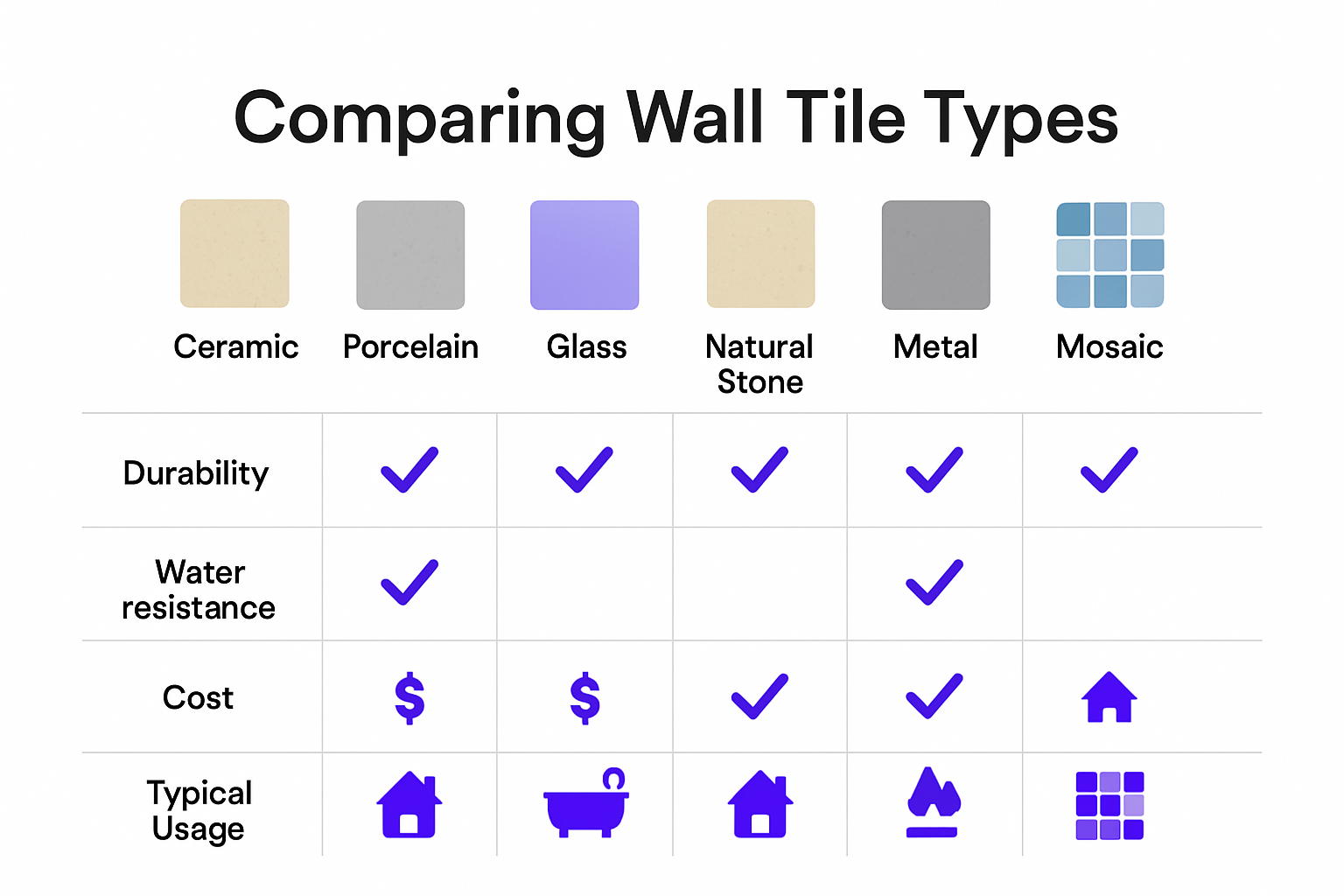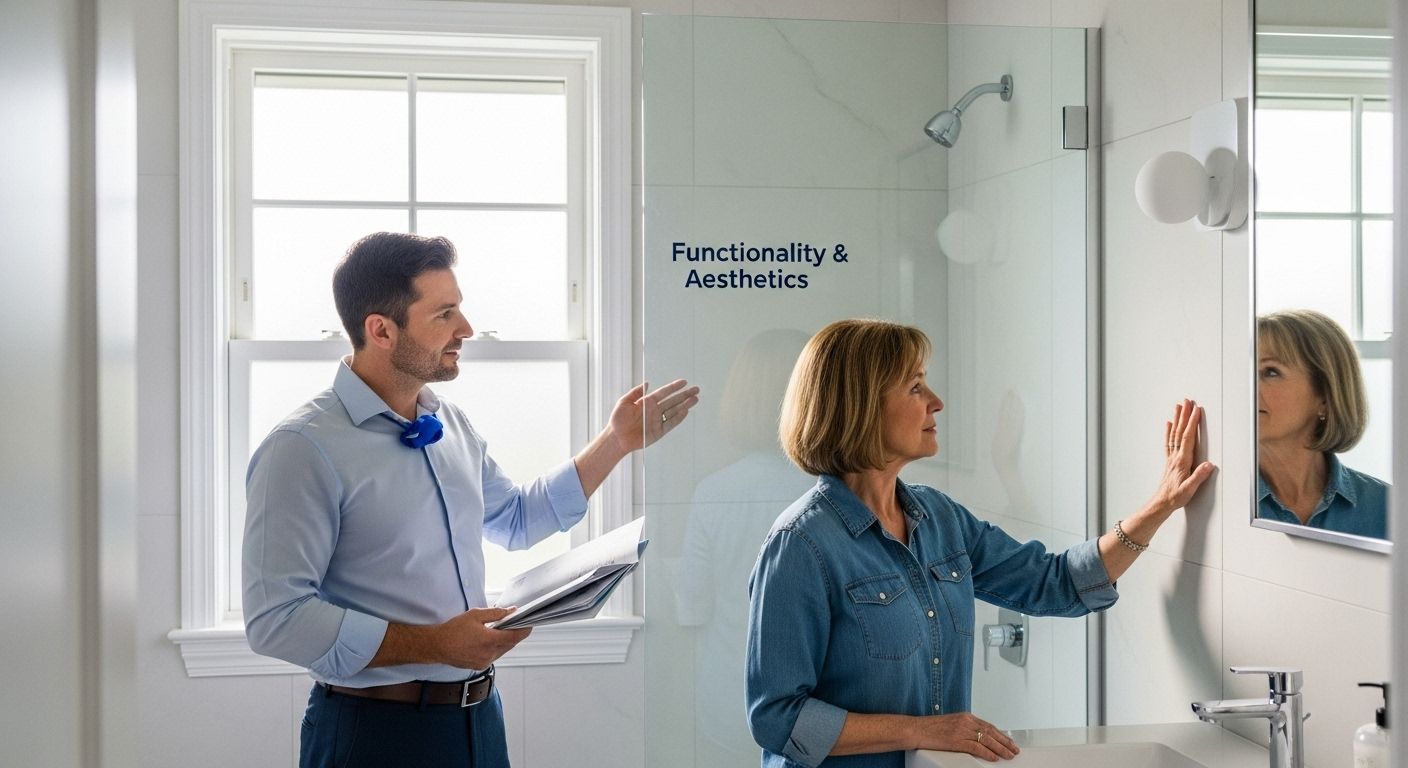What is Wall Tile? Understanding Its Purpose and Benefits
Posted by Mike Belk on Aug 22, 2025

Wall tiles show up in bathrooms, kitchens, hospitals, and high end hotels. Some styles are purely for looks, but most play a big part in keeping spaces hygienic and easy to clean. Ceramic tiles alone cover millions of American walls every year and are prized for being the leading surface for wet and messy spaces thanks to their water resistance. People often think of wall tile as something that’s just practical or old school. Turns out, new designs and materials mean wall tile can completely change the mood and style of a room while also handling whatever life throws at it.
Table of Contents
- Defining Wall Tile: What It Is And Its Common Uses
- The Importance Of Wall Tile In Interior Design
- Exploring Different Types Of Wall Tiles And Their Features
- How Wall Tiles Contribute To Functionality And Aesthetics
- Key Considerations When Choosing Wall Tile For Your Space
Quick Summary
| Takeaway | Explanation |
|---|---|
| Wall tiles are versatile design elements. | Wall tiles enhance aesthetics while providing durability, making them suitable for various environments from homes to commercial spaces. |
| Material selection impacts performance and aesthetic. | Different tiles, such as ceramic and porcelain, offer unique characteristics affecting durability, moisture resistance, and visual appeal. |
| Assess environmental conditions when choosing tiles. | Evaluate factors like moisture exposure and temperature to ensure the selected tiles perform well in their intended space. |
| Wall tiles enhance hygiene and maintenance. | Nonporous tiles resist microbial growth, making them ideal for high traffic areas requiring cleanliness and durability. |
| Design integration is crucial for aesthetic appeal. | Consider color, texture, and pattern to create harmonious interiors that resonate with the desired mood and atmosphere. |
Defining Wall Tile: What It Is and Its Common Uses
Wall tile represents a versatile surface covering designed specifically for vertical installations in residential and commercial environments. These durable materials serve both functional and aesthetic purposes, transforming plain walls into visually appealing and protected surfaces. Explore wall tile options that enhance your space.
Material Composition and Characteristics
Wall tiles are typically manufactured from ceramic, porcelain, glass, natural stone, or composite materials. Each material offers unique properties that determine its performance and visual appeal. Ceramic tiles remain the most common wall tile variety, prized for their durability, water resistance, and affordability. According to the National Park Service, these tiles provide an easily cleanable surface ideal for high-moisture environments.
Practical Applications
The versatility of wall tiles extends across multiple settings and purposes. Common installation areas include:
- Bathrooms (shower walls, vanity backsplashes)
- Kitchens (cooking area backsplashes)
- Commercial spaces (restaurant walls, medical facilities)
- Decorative interior accent walls
- Exterior building facades
Each environment demands specific tile characteristics, such as moisture resistance, stain protection, or decorative design. Homeowners and designers select wall tiles not just for protection but as a critical design element that contributes to the overall aesthetic and functional quality of a space.
The Importance of Wall Tile in Interior Design
Wall tile transcends mere surface coverage, emerging as a powerful design element that dramatically transforms interior spaces. Professional designers recognize wall tiles as strategic tools for creating visual impact, managing functional requirements, and expressing aesthetic narratives. Discover innovative tile design strategies that elevate interior environments.
Aesthetic and Visual Dynamics
Interior design relies on wall tiles to introduce color, texture, pattern, and visual complexity. Unlike paint or wallpaper, tiles offer three dimensional depth and intricate design possibilities. Designers strategically use wall tiles to create focal points, establish visual rhythm, and communicate design themes. Whether implementing minimalist monochromatic arrangements or elaborate mosaic compositions, wall tiles provide unparalleled design flexibility.
Hygienic and Functional Considerations
Beyond aesthetic appeal, wall tiles serve critical functional purposes. According to research in the US National Library of Medicine, nonporous wall tiles create essential barriers against microbial contamination. Their key functional advantages include:
- Resistance to moisture and humidity
- Easy cleaning and maintenance
- Long term durability
- Protection against bacterial growth
- Chemical and stain resistance
These practical attributes make wall tiles indispensable in healthcare facilities, commercial kitchens, bathrooms, and other high traffic environments where cleanliness and durability are paramount.
Exploring Different Types of Wall Tiles and Their Features
Wall tiles represent a diverse category of materials, each offering unique characteristics and performance capabilities. Understanding these variations enables homeowners and designers to select the most appropriate tile for specific environments and design objectives. Discover the nuanced world of tile varieties.
Ceramic and Porcelain Tile Varieties
Ceramic and porcelain tiles dominate the wall tile market, providing exceptional versatility and durability. According to construction material experts, these tiles are manufactured through high temperature firing processes that create dense, resilient surface coverings. Ceramic tiles offer cost effective solutions with moderate durability, while porcelain tiles represent a premium option with superior moisture resistance and strength.
Specialized Wall Tile Materials
Beyond traditional ceramic options, wall tiles encompass a wide range of specialized materials designed for specific aesthetic and functional requirements. These alternative tile types include:
- Glass tiles: Providing translucent, reflective surfaces ideal for creating luminous design elements
- Natural stone tiles: Offering organic textures and unique visual character
- Metal tiles: Delivering industrial and contemporary design aesthetics
- Cement tiles: Creating textured, artisanal wall treatments
- Mosaic tiles: Enabling intricate pattern and design complexity
Each material brings distinctive visual and performance attributes, allowing designers to craft highly personalized interior environments that balance aesthetic appeal with practical functionality.
To help readers compare the unique qualities of popular wall tile materials, the following table summarizes their key characteristics and benefits mentioned in the article.
| Type of Wall Tile | Main Features | Common Uses |
|---|---|---|
| Ceramic | Durable, water-resistant, affordable | Bathrooms, kitchens, accent walls |
| Porcelain | Superior moisture resistance, strong, premium option | High-moisture and heavy-use areas |
| Glass | Translucent, reflective, luminous design effects | Decorative accents, feature walls |
| Natural Stone | Organic texture, unique visual character | Luxury interiors, accent walls |
| Metal | Industrial look, contemporary style | Modern kitchens, focal points |
| Cement | Textured, artisanal appearance | Artistic wall treatments |
| Mosaic | Enables intricate patterns, design complexity | Decorative features, statement art |

How Wall Tiles Contribute to Functionality and Aesthetics
Wall tiles represent a sophisticated design solution that harmoniously blends practical performance with visual sophistication. Beyond mere surface coverage, these materials serve as critical architectural elements that enhance both the functional integrity and aesthetic potential of interior spaces. Explore innovative wall tile design strategies that transform ordinary surfaces.
Functional Performance Characteristics
The primary functional contribution of wall tiles lies in their exceptional protective capabilities. According to neurological research on aesthetic perception, tiles not only serve practical purposes but also trigger complex sensory responses. Their key functional attributes include:
- Moisture barrier protection
- Resistance to bacterial growth
- Easy maintenance and cleaning
- Temperature regulation
- Impact and abrasion resistance
These performance characteristics make wall tiles particularly valuable in high traffic areas like kitchens, bathrooms, and commercial spaces where durability and hygiene are paramount.
Aesthetic and Psychological Impact
Beyond their practical attributes, wall tiles play a profound role in shaping spatial experiences. Designers leverage tiles as powerful visual instruments that communicate style, mood, and architectural narrative. The color, texture, pattern, and arrangement of wall tiles can dramatically influence human perception and emotional engagement with interior environments. Subtle variations in tile design can transform a space from mundane to extraordinary, creating visual depth, rhythm, and sensory complexity that goes far beyond traditional wall treatments.
The table below highlights the major functional and aesthetic advantages of wall tiles as discussed in the article. This overview can help readers quickly grasp how wall tiles serve both practical and decorative roles in various environments.
| Benefit | Functional Role | Aesthetic Role |
|---|---|---|
| Water Resistance | Protects walls from moisture and humidity | Allows use in wet areas with style |
| Easy Maintenance | Simplifies cleaning, resists stains | Retains original appearance over time |
| Durability | Withstands impact, abrasion, and daily wear | Maintains design integrity |
| Hygiene | Resists microbial growth and contamination | Ideal for healthcare and clean spaces |
| Visual Design Flexibility | Not applicable | Offers varied colors, textures, patterns |
| Space Enhancement | Not applicable | Creates depth, rhythm, and mood |

Key Considerations When Choosing Wall Tile for Your Space
Selecting the appropriate wall tile involves a strategic evaluation of multiple factors that extend beyond aesthetic preferences. Homeowners and designers must carefully balance performance requirements, spatial constraints, and design objectives to make informed decisions. Learn essential tile selection strategies that ensure optimal results.
Performance and Environmental Factors
According to the National Park Service, comprehensive tile selection requires thorough assessment of environmental conditions and performance characteristics. Critical evaluation parameters include:
- Moisture exposure levels
- Temperature fluctuation ranges
- Expected mechanical stress
- Cleaning and maintenance requirements
- Potential chemical interactions
- Substrate compatibility
These considerations determine the tile’s long term durability, ensuring that the selected material can withstand specific environmental challenges without compromising structural integrity or aesthetic appeal.
Design and Aesthetic Integration
Beyond technical performance, wall tiles serve as fundamental design elements that communicate spatial character and emotional atmosphere. The selection process demands careful consideration of color psychology, spatial proportions, lighting conditions, and overall design narrative. Designers must evaluate how tile choices interact with existing architectural elements, furniture, and decorative features to create harmonious and visually compelling environments. Subtle variations in tile size, pattern, texture, and finish can dramatically transform a space’s perceived dimensions and emotional resonance.
Transform Your Walls With BELK Tile’s Expertly Curated Selection
Choosing the right wall tile can feel overwhelming when you are trying to balance style, longevity, and functionality. From the article, you know the challenges of selecting materials that look good, provide moisture protection, and stand up to daily wear. BELK Tile understands that your space deserves both beauty and substance, whether you are planning a bathroom, kitchen backsplash, or want to create a unique accent wall. We help solve those pain points by offering an unrivaled variety of ceramic, porcelain, glass, and natural stone wall tiles, all organized by type and application for easy browsing. Browse our inspirational project ideas and see how design, durability, and hygiene can coexist.
Ready to turn what you learned into a real upgrade for your home or project? Visit BELK Tile’s main site for detailed product listings, quick-view shopping tools, and exclusive promos available now. Do not wait. Shop today and find wall tile solutions that blend purpose and style for lasting results.
Frequently Asked Questions
What are the main types of wall tiles?
Wall tiles come in various types, including ceramic, porcelain, glass, natural stone, metal, cement, and mosaic tiles. Each type offers unique visual and functional characteristics suited for different design needs.
What are the primary benefits of using wall tiles?
Wall tiles provide several benefits, including water resistance, easy maintenance, durability, hygiene, and aesthetic appeal. They are ideal for high-moisture environments like bathrooms and kitchens and can enhance the overall look of any space.
How do I choose the right wall tile for my space?
Choosing the right wall tile involves assessing factors like the moisture exposure levels, temperature fluctuations, expected mechanical stress, cleaning requirements, and potential chemical interactions. It’s also important to consider the design narrative and how the tile integrates with existing elements in the space.
Can wall tiles affect indoor air quality?
Yes, wall tiles, particularly nonporous options, can help improve indoor air quality by acting as barriers against moisture and reducing the growth of harmful bacteria. Their easy-to-clean surfaces minimize dirt and grime buildup, contributing to a healthier environment.



